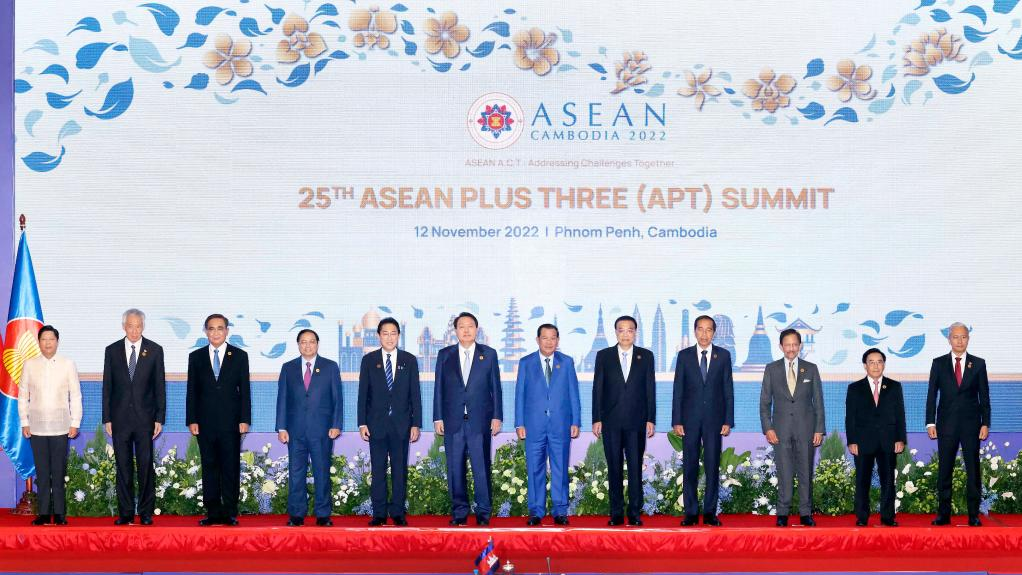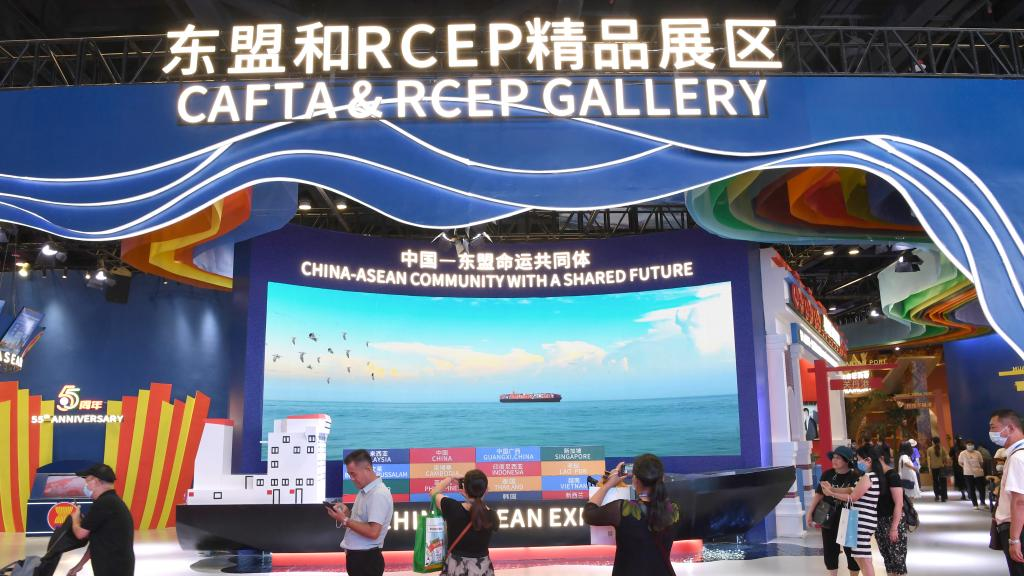
Chinese Premier Li Keqiang (5th R) poses for a group photo with leaders attending the ASEAN, China, Japan and South Korea (ASEAN Plus Three or APT) Summit in Phnom Penh, Cambodia, November 12, 2022. /Xinhua
Chinese Premier Li Keqiang (5th R) poses for a group photo with leaders attending the ASEAN, China, Japan and South Korea (ASEAN Plus Three or APT) Summit in Phnom Penh, Cambodia, November 12, 2022. /Xinhua
Editor's note: Hamzah Rifaat Hussain, a former visiting fellow at the Stimson Center in Washington and former assistant researcher at the Islamabad Policy Research Institute, is a TV anchor at Indus News in Pakistan. The article reflects the author's opinions and not necessarily those of CGTN.
A year after China and ASEAN (Association of Southeast Asian Nations) commemorated the 30th anniversary of their dialogue relations, the 25th Summit of 2022 in Phnom Penh in Cambodia resulted in a joint statement calling for realizing tangible prosperity, implementing practical steps for sustainable development and promoting greater economic resilience for both sides. By taking the lead from Chinese Premier Li Keqiang expressing hope that a stronger, all-encompassing and comprehensive relationship between the two sides should materialize, China and ASEAN can prosper together through investments in peace frameworks by capitalizing on historical precedents, promoting economic integration strategies and executing capacity building measures for a securer future.
Understandings were reached on strategies to achieve sustainable development goals over environmental conservation, such as the China-ASEAN Joint Statement on Enhancing Green and Sustainable Development Cooperation of 2021. This compliments ASEAN trading partners, as well as China pledging towards decarbonizing their economies by 2060.
The development of green economies in ASEAN member states ranging from Singapore to the Philippines would provides $1 trillion worth of opportunities that are crucial for economic revival and resilience. The proposals in the joint statement speak of multipronged approaches, such as strengthening development of emerging technologies and promoting green investment and financing through establishing the China-ASEAN Clean Energy Cooperation Center.
Furthermore, China's Global Development Initiative (GDI) is implementing the UN 2030 Agenda for Sustainable Development. UN Secretary General Antonio Guterres in 2021 acknowledged that Chinese President Xi Jinping's GDI has revived global efforts to achieve sustainable development goals which apply to the ASEAN region as well. The GDI offers practical solutions for confidence building measures over tackling hunger and poverty connected to quality education and infrastructural development. Additionally, development financing is addressing each of these critical areas to ensure that the Sustainable Development Goals are achieved by 2030 by all ASEAN member states.

The CAFTA & RCEP Gallery during the 19th China-ASEAN Expo in Nanning, China, September 19, 2022. /Xinhua
The CAFTA & RCEP Gallery during the 19th China-ASEAN Expo in Nanning, China, September 19, 2022. /Xinhua
To tackle socio-economic and geopolitical challenges including mitigating the impact of the Ukraine conflict on regional security, and non-traditional security threats such as illicit drug trade in Southeast Asia with trafficking hitting record levels in 2021 as per the United Nations Office on Drugs and Crime, both China and ASEAN support the four areas of the ASEAN Outlook on the Asia Pacific, which includes maritime cooperation and connectivity. Across the board security hinges on intelligence sharing between all states, which are where the ASEAN-China Digital Economy Cooperation that includes cooperation on artificial intelligence and cybersecurity from 2020 gains added relevance.
Hence, both sides can tackle joint threats to national and regional security by leveraging technology as a preemptive measure. Similarly, tackling non-traditional security threats such as the pandemic and natural disasters can be improved with implementation of the China-ASEAN Work Plan on Disaster Management from 2021-2025 that promote an uninhibited supply of vaccines and medicines to affected countries. Such measures can boost confidence building measures between the two sides while initiatives such as the Programme on Public Health Emergency Preparedness Capacity endeavors are upgrading the health infrastructure of member states, such as Indonesia to cope with a sudden surge in pandemics, health crisis and medical emergencies.
To consolidate sound trade ties by enhancing the China-ASEAN Free Trade Area and implementing the Regional Comprehensive Economic Partnership, which all ASEAN member states are participating in is essential. As of August, 2022, China-ASEAN trade touched $554.9 billion and accounted for 15 percent of China's total foreign trade. Li Fei, assistant commerce minister of China, also said that cumulative two-way investments by the end of July 2022 exceeded $340 billion.
Unimpeded trade and support to indigenous industries can be complimented by the ASEAN-China Cooperation Fund, which was launched in 1997 to diversify cooperation in areas such as agriculture, human resource development, trade, tourism and education. By leveraging international and regional financial institutions such as the World Bank, Asian Infrastructure Bank and Asian Development Bank to provide financial resources to ASEAN states can contribute to the economic health of the region. This bodes well for trade ties between the two sides, as well as with strategic goals for the future that can be realized through joint visions of economic prosperity.
The joint statement issued by both China and ASEAN at the 25th China ASEAN Summit covers several dimensions that deal with sustainable development, regional peace and realizing joint prosperity. By touching on an array of different subjects, China and ASEAN can take the lead to shape regional architectures through ASEAN-led mechanisms.
It's a win-win situation for both sides.
(If you want to contribute and have specific expertise, please contact us at opinions@cgtn.com. Follow @thouse_opinions on Twitter to discover the latest commentaries in the CGTN Opinion Section.)